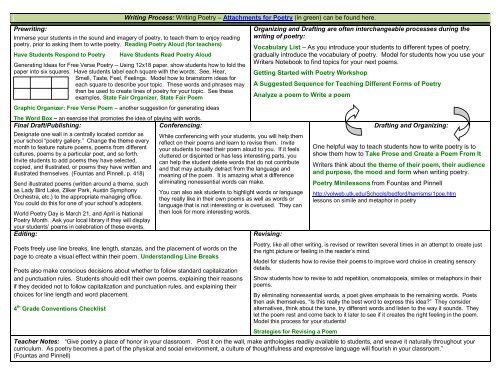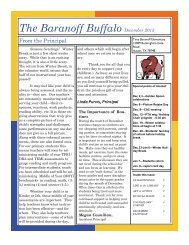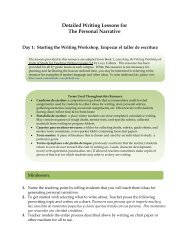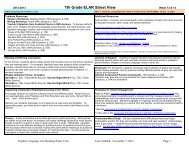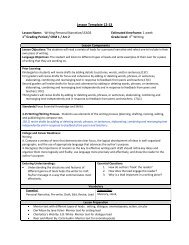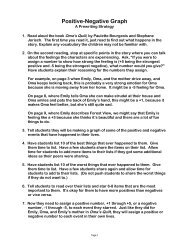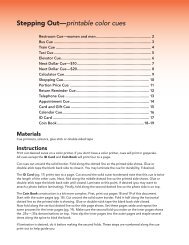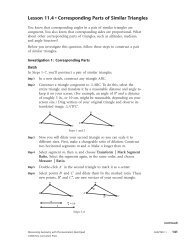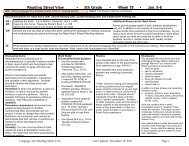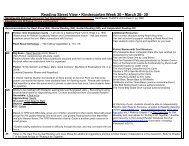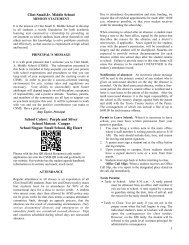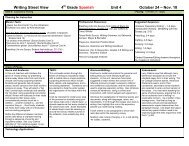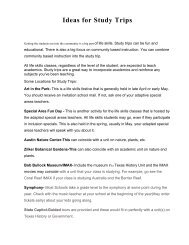Writing Street View 4th Grade Unit 6 January 7 25, 2013 - Office of ...
Writing Street View 4th Grade Unit 6 January 7 25, 2013 - Office of ...
Writing Street View 4th Grade Unit 6 January 7 25, 2013 - Office of ...
You also want an ePaper? Increase the reach of your titles
YUMPU automatically turns print PDFs into web optimized ePapers that Google loves.
Prewriting:<strong>Writing</strong> Process: <strong>Writing</strong> Poetry – Attachments for Poetry (in green) can be found here.Immerse your students in the sound and imagery <strong>of</strong> poetry, to teach them to enjoy readingpoetry, prior to asking them to write poetry. Reading Poetry Aloud (for teachers)Have Students Respond to PoetryHave Students Read Poetry AloudGenerating Ideas for Free Verse Poetry – Using 12x18 paper, show students how to fold thepaper into six squares. Have students label each square with the words: See, Hear,Smell, Taste, Feel, Feelings. Model how to brainstorm ideas foreach square to describe your topic. These words and phrases maythen be used to create lines <strong>of</strong> poetry for your topic. See theseexamples. State Fair Organizer, State Fair PoemGraphic Organizer: Free Verse Poem – another suggestion for generating ideasThe Word Box – an exercise that promotes the idea <strong>of</strong> playing with words.Final Draft/Publishing:Conferencing:Designate one wall in a centrally located corridor asyour school “poetry gallery.” Change the theme everymonth to feature nature poems, poems from differentcultures, poems by a particular poet, and so forth.Invite students to add poems they have selected,copied, and illustrated, or poems they have written andillustrated themselves. (Fountas and Pinnell, p. 418)Send illustrated poems (written around a theme, suchas Lady Bird Lake, Zilker Park, Austin SymphonyOrchestra, etc.) to the appropriate managing <strong>of</strong>fice.You could do this for one <strong>of</strong> your school’s adopters.World Poetry Day is March 21, and April is NationalPoetry Month. Ask your local library if they will displayyour students’ poems in celebration <strong>of</strong> these events.Editing:Organizing and Drafting are <strong>of</strong>ten interchangeable processes during thewriting <strong>of</strong> poetry:Vocabulary List – As you introduce your students to different types <strong>of</strong> poetry,gradually introduce the vocabulary <strong>of</strong> poetry. Model for students how you use yourWriters Notebook to find topics for your next poems.Getting Started with Poetry WorkshopA Suggested Sequence for Teaching Different Forms <strong>of</strong> PoetryAnalyze a poem to Write a poemWhile conferencing with your students, you will help themreflect on their poems and learn to revise them. Inviteyour students to read their poem aloud to you. If it feelscluttered or disjointed or has less interesting parts, youcan help the student delete words that do not contributeand that may actually detract from the language andmeaning <strong>of</strong> the poem. It is amazing what a differenceeliminating nonessential words can make.You can also ask students to highlight words or languagethey really like in their own poems as well as words orlanguage that is not interesting or is overused. They canthen look for more interesting words.Poets freely use line breaks, line length, stanzas, and the placement <strong>of</strong> words on thepage to create a visual effect within their poem. Understanding Line BreaksPoets also make conscious decisions about whether to follow standard capitalizationand punctuation rules. Students should edit their own poems, explaining their reasonsif they decided not to follow capitalization and punctuation rules, and explaining theirchoices for line length and word placement.4 th <strong>Grade</strong> Conventions ChecklistRevising:Drafting and Organizing:One helpful way to teach students how to write poetry is toshow them how to Take Prose and Create a Poem From ItWriters think about the theme <strong>of</strong> their poem, their audienceand purpose, the mood and form when writing poetry.Poetry Minilessons from Fountas and Pinnellhttp://volweb.utk.edu/Schools/bedford/harrisms/1poe.htmlessons on simile and metaphor in poetryPoetry, like all other writing, is revised or rewritten several times in an attempt to create justthe right picture or feeling in the reader’s mind.Model for students how to revise their poems to improve word choice in creating sensorydetails.Show students how to revise to add repetition, onomatopoeia, similes or metaphors in theirpoems.By eliminating nonessential words, a poet gives emphasis to the remaining words. Poetsthen ask themselves, “Is this really the best word to express this idea?” They consideralternatives, think about the tone, try different words and listen to the way it sounds. Theylet the poem rest and come back to it later to see if it creates the right feeling in the poem.Model this process for your students!Strategies for Revising a PoemTeacher Notes: “Give poetry a place <strong>of</strong> honor in your classroom. Post it on the wall, make anthologies readily available to students, and weave it naturally throughout yourcurriculum. As poetry becomes a part <strong>of</strong> the physical and social environment, a culture <strong>of</strong> thoughtfulness and expressive language will flourish in your classroom.”(Fountas and Pinnell)


